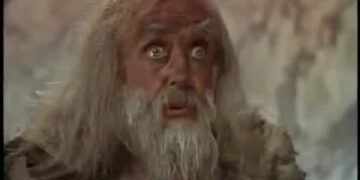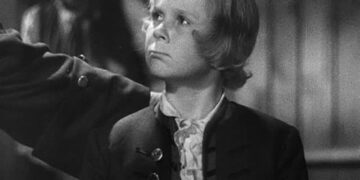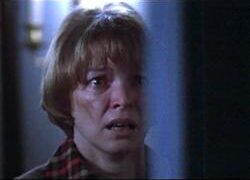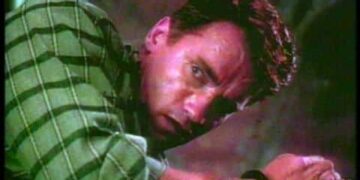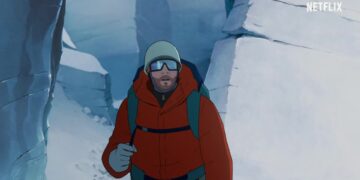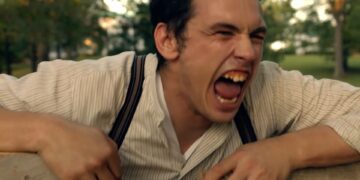Fantastic Planet (1973) is an iconic and influential animated science fiction film directed by René Laloux and based on the book “Oms en série” by Stefan Wul.
The movie is renowned for its unique visual style, soundtrack by Alain Goraguer, and thought-provoking themes.
In this article, we’ll explore the book and movie’s storylines, compare the adaptations, and delve into the film’s unforgettable characters, quotes, and curiosities.
We’ll also discuss the lasting impact of Fantastic Planet and provide tips for cosplay, a parent guide, and book club questions.
Stefan Wul: The author behind the story
Stefan Wul was a French science fiction writer known for his imaginative and evocative novels. Born Pierre Pairault in 1922, Wul published numerous books under his pseudonym, with “Oms en série” being one of his most famous works.
Though best known for his science fiction, Wul also wrote in other genres and even composed music scores. His novels often explore themes of humanity, society, and the relationship between humans and other species.
Book summary: Oms en série
“Oms en série” is a captivating science fiction novel that tells the story of Terr, a young human known as an “Om.”
On the distant planet of Ygam, the giant blue Draags have enslaved the Oms for generations, using them for labor and entertainment. Terr, an orphan raised by a Draag named Tiwa, discovers the Draags are planning to exterminate the Oms.
He escapes, joining a group of rebel Oms, and uses his knowledge of Draag technology to help his fellow Oms fight for their freedom.
The novel delves into themes of societal hierarchy, oppression, and resistance. It also examines the nature of humanity and the potential for change, as Terr and the Oms learn to adapt and survive in their harsh environment.
René Laloux: The visionary director
René Laloux was a French filmmaker born in 1929, known for his innovative and thought-provoking work in the realm of animated science fiction.
He studied at the í‰cole des Beaux-Arts in Paris and later worked as a puppeteer and animator.
Laloux’s collaboration with illustrator Roland Topor resulted in Fantastic Planet, which won the Special Jury Prize at the 1973 Cannes Film Festival.
Laloux continued to create groundbreaking animation throughout his career, including the films “Time Masters” (1982) and “Gandahar” (1988).
Movie summary: Fantastic Planet (1973)
Fantastic Planet is a visually stunning and thought-provoking animated film that follows the story of Terr, an Om living on the planet Ygam.
The Draags control the Oms, treating them as pets or pests. Terr, raised by Tiwa, learns about Draag culture, technology, and their plans to exterminate the Oms.
He escapes to join a group of rebel Oms and uses his knowledge to help them fight for their survival and freedom.
The film’s unique visual style and evocative soundtrack by Alain Goraguer create an immersive and otherworldly experience, transporting viewers to the strange and intriguing world of Ygam.
Comparing the book and film adaptations
Both the book and film adaptations of Fantastic Planet and Oms en série share a common storyline, exploring themes of oppression, resistance, and the struggle for survival.
However, there are notable differences between the two adaptations, particularly in terms of character development and the portrayal of the Draags.
Intriguing differences between the book and movie
While the overall plot remains similar, the film adaptation of Fantastic Planet offers a more visually rich and surreal take on the story.
Some of the key differences between the book and the movie include the representation of the Draags, who appear more alien and less human-like in the film.
Additionally, the movie simplifies certain aspects of the story, such as the Oms’ journey to freedom and their development of advanced technology.
Analyzing the film’s unique visual style and soundtrack by Alain Goraguer
Fantastic Planet’s distinctive visual style, created by illustrator Roland Topor, is one of the film’s most memorable aspects.
The hand-drawn animation features surreal landscapes, bizarre creatures, and intricate details that transport viewers to the strange world of Ygam.
The soundtrack, composed by Alain Goraguer, further enhances the film’s atmosphere, blending jazz, electronic, and orchestral elements to create a haunting and otherworldly soundscape.
The characters of Fantastic Planet: Who’s who
The main characters in Fantastic Planet include Terr, the young Om protagonist; Tiwa, the Draag who raises Terr; and the various Oms and Draags who inhabit the world of Ygam.
Each character plays a crucial role in the story, as they navigate the complex relationships between the two species and their struggle for survival.
Memorable quotes from the book and film
Throughout both the book and film adaptations, several memorable lines stand out.
Some of the most notable quotes include:
- “Knowledge is the only weapon I have against the Draags.” – Terr
- “To be an Om is to be one with the earth.” – Om rebel leader
- “We are the masters of our own destiny.” – Draag leader
These quotes highlight the themes of resistance, self-determination, and the importance of knowledge in the face of oppression.
A parent guide to Fantastic Planet
Fantastic Planet is an animated film that explores mature themes such as oppression, resistance, and survival.
Though visually captivating, the film may be too intense and thought-provoking for younger children.
Parents should consider watching the film with their children and engaging in discussions about the story’s themes and messages.
Tips for cosplay: Dressing like your favorite characters
Cosplaying as characters from Fantastic Planet can be a fun and creative endeavor.
Consider these tips for dressing like your favorite characters:
- Terr: Create a simple tunic and pants from earth-toned fabric, and add a belt made from rope or cord.
- Tiwa: Construct a flowing robe from blue fabric and create a headpiece with large, round ears to emulate the Draag’s distinctive appearance.
- Om rebel: Dress in rugged, earth-toned clothing and accessorize with makeshift weapons and tools.
Curiosities and trivia about Fantastic Planet
Some interesting facts about Fantastic Planet include:
- The film was a collaboration between French and Czechoslovakian animators, resulting in a unique fusion of artistic styles.
- Fantastic Planet was initially banned in several countries due to its political allegory and graphic content.
- The film’s unique visual style was inspired by surrealist painters and illustrators.
Exploring the themes and messages of Fantastic Planet
At its core, Fantastic Planet explores themes of oppression, resistance, and the struggle for survival.
The story serves as a powerful allegory for real-world issues, such as racism, class struggle, and the abuse of power.
Additionally, the film delves into the nature of humanity, questioning the boundaries between humans and other species.
Ending explained: The significance of the film’s conclusion
In the film’s conclusion, the Oms and Draags reach a tenuous peace, as the Oms prove their intelligence and ability to coexist with their former oppressors.
This ending serves as a hopeful message about the potential for change, understanding, and reconciliation between different species and cultures.
Other media by René Laloux
Beyond Fantastic Planet, René Laloux also directed other groundbreaking animated films, such as “Time Masters” (1982) and “Gandahar” (1988).
These films showcase Laloux’s unique visual style, thought-provoking themes, and innovative storytelling.
Similar media to Fantastic Planet and Oms en série
Fans of Fantastic Planet and Oms en série may also enjoy other works by Stefan Wul, such as “The Temple of the Past” and “The Orphans of the Sky.”
Additionally, other animated films with thought-provoking themes and unique visual styles include “Wizards” (1977) by Ralph Bakshi and “Heavy Metal” (1981).
Fantastic Planet in popular culture: Remakes, sequels, and spin-offs
While there have been no official remakes, sequels, or spin-offs of Fantastic Planet, the film’s influence can be seen in various forms of media, from music videos to video games.
Its unique visual style and thought-provoking themes continue to inspire artists, filmmakers, and writers today.
A travel guide to visit Fantastic Planet-inspired locations
While the world of Fantastic Planet is purely fictional, fans can still find inspiration in visiting real-life locations with otherworldly landscapes and architecture.
Some suggestions include the surreal rock formations of Cappadocia, Turkey; the fantastical architecture of Antoni Gaudi in Barcelona, Spain; and the alien-like landscapes of Iceland’s volcanic regions.
Book club questions for Fantastic Planet and Oms en série
- How do the themes of oppression and resistance resonate with you?
- What are the most significant differences between the book and film adaptations, and how do they impact the story?
- What do you think the ending of Fantastic Planet signifies?
- How does Fantastic Planet challenge traditional notions of humanity and other species?
- Discuss the film’s unique visual style and soundtrack. How do they contribute to the overall atmosphere and message of the story?
Conclusion: The lasting impact of Fantastic Planet
Fantastic Planet remains a powerful and influential work of science fiction, with its imaginative story, unique visual style, and thought-provoking themes continuing to captivate audiences.
As we uncover the book summary, movie summary, and intriguing differences between the adaptations, we can appreciate the lasting impact of René Laloux’s masterpiece and its significance in the world of science fiction and animation.


